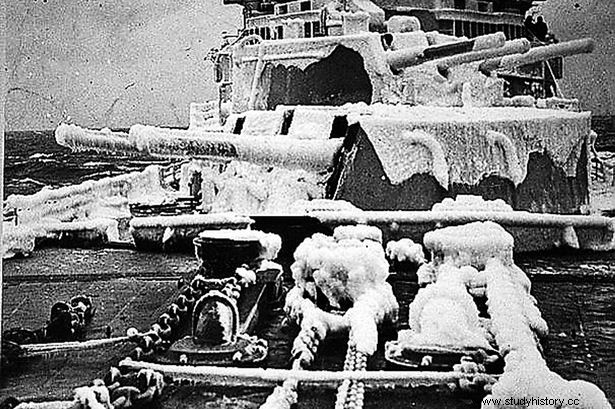In June 1941, Hitler begins the offensive on the Eastern Front to invade the Soviet Union (Operation Barbarossa), an overly ambitious plan. The brutal German offensive managed to break through the unsuspecting Red Army defenses and quickly gain ground. However, the arrival of winter stabilized the front allowing the Red Army to group together and disrupt Hitler's plans. But the Soviets were not alone, they received help from the Arctic Convoys. In the words of Winston Churchill…
The worst journeys in the world
England knew that if Germany was successful on the Eastern Front during the invasion of the
Soviet Union, she would refocus all of her forces on the Western Front. So if they were helping the Soviets keep the Germans at bay, they were also doing it for their own benefit. Logically, they could not send supplies or weapons by land
or air, there was only the option of the sea... from Iceland and, above all, from the United Kingdom through the Arctic Ocean to the Soviet ports of Murmansk and
Arkhangelsk. Since August 1941, 78 convoys managed to deliver
four million tons of weapons (7,000 planes, 5,000 tanks, ammunition...)
fuel, food and medicine. 1,400 merchant ships protected
by warships of the British Royal Navy and 66,000 British soldiers and merchant sailors intervened. In addition to the obvious benefits of the aid provided, for Stalin it was conclusive proof
that the Allies were not going to leave them alone in their confrontation with
Hitler.
In peacetime it would not have been necessary to reach the Arctic, but Germany controlled
the Scandinavian peninsula and patrolled the waters of the North Atlantic with warships,
Luftwaffe aircraft and the fearsome U-boats ( submarines). So the safest alternative was the Arctic route. In addition to the Germans, they faced a greater danger:
extreme cold, storms, huge waves... and icebergs.
We learned what extreme cold was when grasping the chains and cables without gloves, we tore our skin off. […] The cold was unimaginable, but
we had to go out to chip away at the ice that formed on the deck, tied with
ropes […] Sometimes the boat tilted up to 45º…

If during the winter the problem was the terrible weather conditions, during the
arctic summer, with its corresponding hours of almost perpetual sunshine and the difficulties in
falling asleep, the convoys were forced to sail at full speed. light making it easier for the Germans to locate them...85 merchant ships, 16 Royal Navy ships and more than
3,000 British were lost in the mission to aid the Soviets.

After World War II, tensions with the Soviet Union left these heroes of the Arctic marginalized from any recognition. Seventy years later, when David Cameron became Prime Minister of the United Kingdom, they got the recognition they had been fighting for decades... only about 200 veterans of the Arctic convoys were still alive.
The important thing is not the medals, but the stories behind them.
Video:
As tomorrow is a good day to give or buy a book...

